The Pensacola Lighthouse and Maritime Museum offers the opportunity to learn more about the history of the lighthouse and climb to the top!
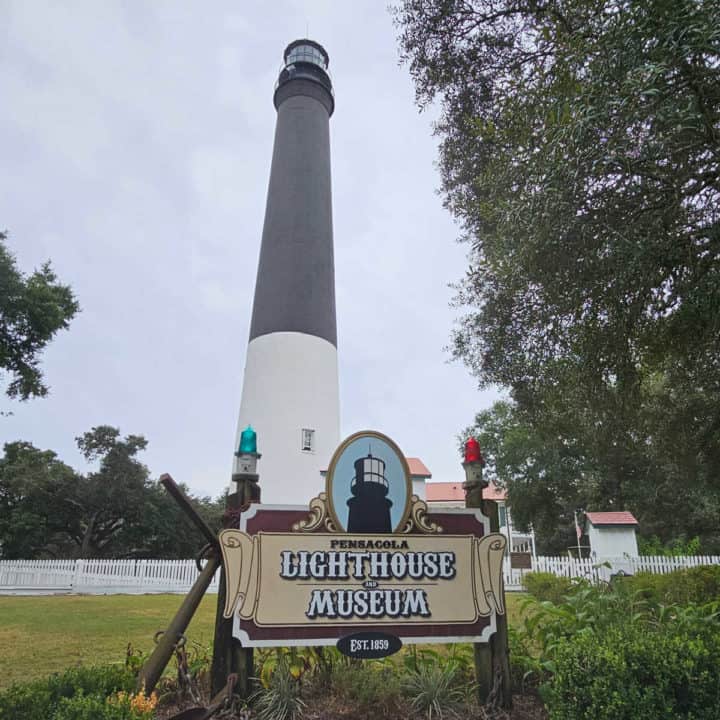
Pensacola Lighthouse & Maritime Museum
A visit to the Pensacola Lighthouse offers visitors and locals the opportunity to learn more about the impact of this historic lighthouse.
Adventure seekers will love climbing the stairs to the top and checking out amazing views. History lovers will find the museum fascinating.
The lighthouse was authorized by Congress on March 3, 1823 for $6,000! Winslow Lewis responded to an advertisement in March 1824 saying he would built the light house.
The initial lighthouse was used until 1858 when a new lighthouse was built a half mile west of the original lighthouse.
Construction was completed in 1858, and the lamp in the tower’s first-order Fresnel lens was first lit on New Year’s Day, 1859 by Keeper Palmes.
In 1861, Florida seceded from the United States. Fort Barrancas was abandoned by Union forces during the Civil War in favor of Fort Pickens. This allowed the Confederates to take control of the lighthouse.
In November 1861 the "Lighthouse Batteries" were targets for guns from Fort Pickens and approximately a half dozen rounds struck the tower of the lighthouse.
None of the rounds were able to penetrate the outer walls of the lighthouse. The lighthouse was re-lit on December 20, 1862 with a fourth-order lens.
On August 31, 1886 a rare earthquake shook the lighthouse tower. In 1939 the Pensacola Light Station received electricity and was transferred to the Coast Guard.
Gulf Islands National Seashore was created in 1971 to help preserve the lighthouse along with Fort Barrancas and Fort Pickens.

Climb the Historic Pensacola Lighthouse
From the top of the Pensacola Lighthouse, you can see beautiful views of Pensacola Pass, where Pensacola Bay meets the Gulf of Mexico, three historic forts, the Pensacola city skyline, and the historic Naval Yard.
Our friend Rob from 2 Travel Dads climbed to the top while I explored the museum and grounds. He said the climb is amazing.
Requirements include:
- Climbers must be at least 44" tall or 7 years old. Children 12 & under can not climb without a ticketed adult.
- Shoes must have an enclosed back. No Birkenstocks or Flip Flops. No spike heels.
The spiral staircase includes 177 steps to the top of the tower.
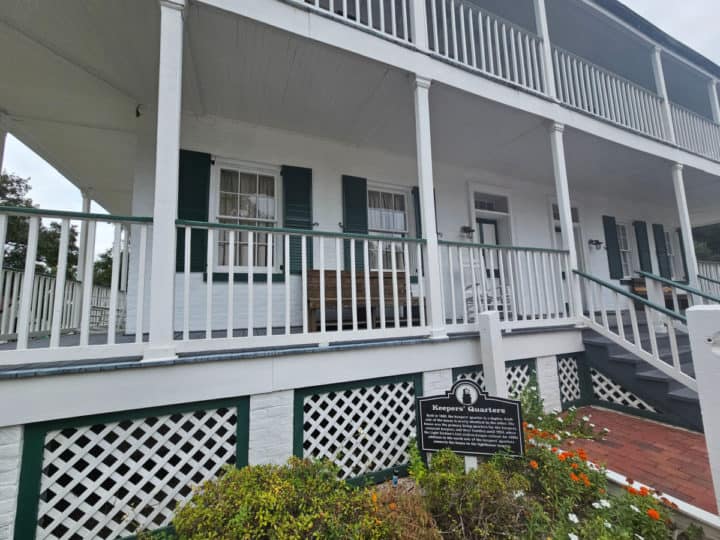
Richard C. Callaway Museum
Located in the fully restored Keeper's Quarters, which were built in 1869, is the Richard C. Callaway Museum.
Plan time to explore the museum and learn more about the lighthouse keepers and their families who lived in the building until 1965.
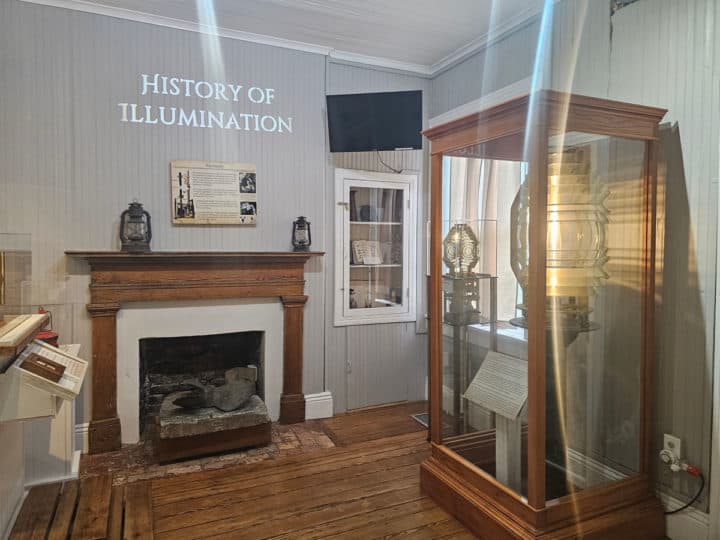
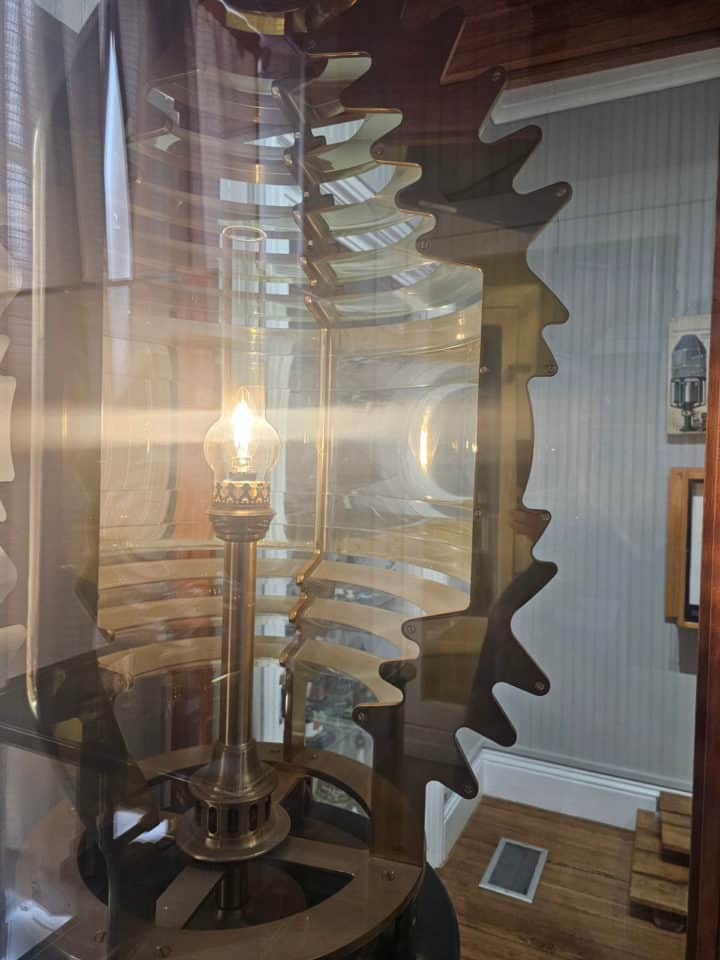
The History of Illumination exhibit is really interesting. It covers the evolution of lighthouse illumination techniques, including Fresnel Lenses.
There are also exhibits on the Women who lit the way, Industries of Pensacola, and a living history area where you can see how the Light Keepers lived.
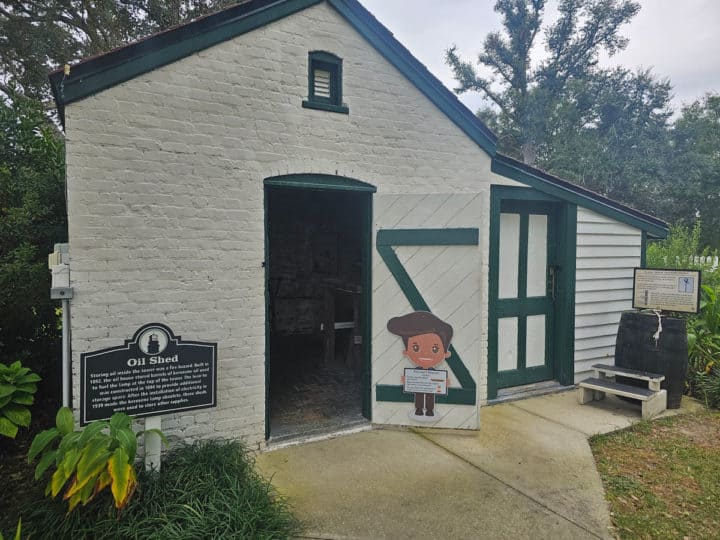
The Oil Shed was built in 1892 and used to store barrels of kerosene that were used to fuel the lighthouses lamp.
Ghost Hunt
You can join a ghost hunt in the historic 1969 Keeper's Quarters and see if you encounter any ghosts.
The Travel Channel and SciFi's Ghost Hunters and paranormal investigators have ghost hunted at the lighthouse.
Blue Angels Practice Viewing
When the Blue Angels are home in Pensacola they practice a couple of times a week from NAS Pensacola. You can reserve a spot at the top of the lighthouse to get an unbelievable view of practice.
Sunset and Full Moon Climb are also offered and give the rare opportunity to view the magnificent first-order Fresnel lens as it casts its beams 27 miles out to sea guiding mariners to safe harbor.
When we checked there were no dates listed for this climb right now. Check out the current Blue Angels Practice Schedule.
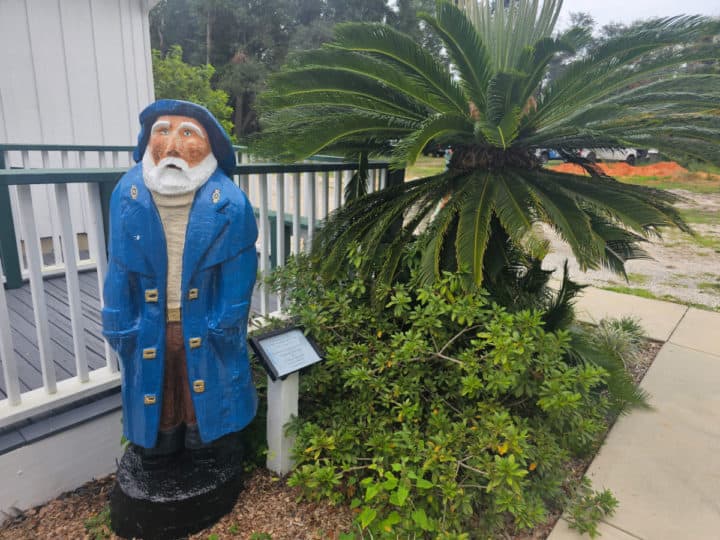
Pensacola Lighthouse History
The Pensacola Lighthouse, an iconic structure overlooking the Gulf of Mexico, is a testament to Pensacola's rich maritime history. This historic lighthouse, established in 1859, has guided countless ships through the perilous waters of Pensacola Bay.
Not only has the Pensacola Lighthouse guided many ships safely into the harbor, but it has survived being struck by lightning twice, an earthquake, and being shelled by Union forces during the American Civil War!
The Pensacola Lighthouse is one of six lighthouses that are examples of classic brick lighthouses still left in the United States.
These early classic lighthouses represent some of the oldest and most traditional designs, typically characterized by their brick construction, common in the 18th and early 19th centuries, making the Pensacola Lighthouse a must-see destination for history enthusiasts!
A Brief History of Pensacola
Pensacola has a long history. The Spanish were the first Europeans to settle here in 1559, making it the oldest European settlement in mainland America. However, due to the extreme weather experienced in Pensacola, the settlement did not last long, and the area was deemed too dangerous to settle.
It would be another 135 years before people began to settle in Pensacola again. In the early 1800s, Spain had control of Pensacola and established Fort Barrancas to protect the entrance to the bay.
In 1821, Florida came under the control of the United States. The United States government recognized the importance of protecting Pensacola’s harbor and started to develop the idea of establishing a lighthouse and naval base here.
Throughout its history, Pensacola has been controlled by the Spanish, French, British, The Confederate States of America, and finally, the United States of America. Because of this, Pensacola earned the nickname “City of Five Flags.”
Establishing the First Pensacola Lighthouse
In March 1823, Congress allocated $6,000 to build the Pensacola Lighthouse to guide ships into the harbor. While the lighthouse was being constructed, the lightship known as the Aurora Borealis was moved from the mouth of the Mississippi to the calmer waters behind Santa Rosa Island.
The site for the new lighthouse was just west of Fort Barrancas. The site was chosen because the light from the lighthouse would be able to direct ships into the Pensacola Harbor. Winslow Lewis built the lighthouse and the lighthouse keeper's home.
Construction on the original Pensacola Lighthouse began in April 1824, and was first lit on December 20. To guide ships into the harbor, two groups of five lamps attached to opposite ends of a framework were rotated.
Jeremiah Ingraham was the first lighthouse keeper and would continue to guide ships into the harbor until he died in 1840, at which time his wife became the lighthouse keeper, serving until her death in 1855.
In the 1850s, several complaints were made against the effectiveness of the lighthouse. People complained that the light was not bright enough. Another complaint was that the light was being blocked by trees on Santa Rosa Island.
The Second Pensacola Lighthouse
Due to the complaints received about the first lighthouse, it was decided that a second Pensacola Lighthouse would be built half a mile west of the original lighthouse.
The new Pensacola Lighthouse was to have a 150-foot tower. John Newton, an engineer in the Army Corps of Engineers, oversaw the construction of the new lighthouse.
Congress allocated $25,000 to build what they described as a “first-class seacoast light” but soon allocated an additional $30,000 to the project. The Pensacola Lighthouse was completed in 1858. The tower of the lighthouse, which was painted white, ended up being 159 feet tall. The first-order federal lens was lit for the first time on the first of January.
The Pensacola Lighthouse During the American Civil War
When Florida seceded from the Union in January 1861,Confederate forces quickly moved to secure key military installations in the area, including the Pensacola Lighthouse. America erupted into the Civil War on April 12, 1861.
While the Confederate soldiers took control of the Pensacola Lighthouse, the Union soldiers occupied Fort Pickens on Santa Rosa Island. The Confederates removed the lens from the lighthouse, ensuring that the Pensacola Lighthouse could not operate.
On November 22, 1861, after months of observing each other’s movements, the two sides finally engaged in battle. The artillery exchange lasted two days, during which the lighthouse was hit multiple times by Union shells. Luckily none of the shells managed to break through the walls of the tower.
Despite the two-day battle in November 1861, the Confederates continued to occupy the lighthouse until May 1862. The Confederates abandoned their position on May 9, and the Union quickly occupied the Pensacola Lighthouse.
While under Union control, a fourth-order lens replaced the lens in the lantern room that had been removed by the Confederates. The Pensacola Lighthouse once again lit the way into the harbor on December 20, 1862.
The first-order lens that had been removed by the Confederates was eventually recovered and re-installed in 1869. A new house for the lighthouse keeper was also built that year, and the top half of the tower was painted black.
Why you will love the Pensacola Lighthouse
- Listed on the National Register of Historic Places
- You can climb 177 stairs to the top of the lighthouse
- Epic views
- See an original first order Fresnel lens
- Amazing preservation and restoration of a historic lighthouse
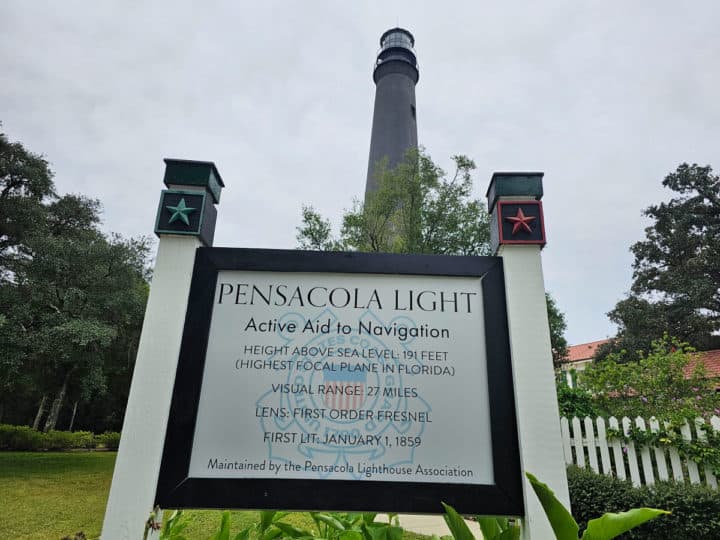
Things to know when planning a visit to the Pensacola Lighthouse
One thing to always remember when planning a visit is the lighthouse is located on an active military base.
Make sure you always have your ID with you are all times. If you are visiting with someone who is not a US Citizen there are extra steps that need to be taken.
If you are visiting during the summer or hot season please bring a water bottle with you and be prepared for heat and humidity! There is a bottle refill station available at the lighthouse.
Oversized purses and backpacks are not allowed on the property
Address - 2081 Radford Blvd, Pensacola, FL 32508
In order to reach the Pensacola Lighthouse, you will need to enter through the NAS Pensacola Public Gate with a proper ID.
Public access to Naval Air Station Pensacola is available from 9 AM-3 PM through the West Gate only!
NAS = Pensacola Naval Air Station
Phone - 850-393-1561
Hours - Open daily from 9 am to 4 pm, with the last admission sold at 3:40 pm.
Please confirm with the restaurant to ensure that the hours have not changed.
Please note that on days the Blue Angels are scheduled to fly, the Lighthouse Tower is open only to guests with reservations to watch the show.
Closed on Easter Sunday, Thanksgiving Day, Christmas Eve, Christmas Day, New Year's Eve, and New Year's Day.
Accessibility - Parking spaces with an accessibility placard are located in the main parking lot along the fence line.
The first floor of the Pensacola Lighthouse Museum is accessible via a ramp on the east side of the building.
Dress Code/Suggestions - Casual.
If you plan to climb the Pensacola Lighthouse you must be wearing shoes with an enclosed back!
Parking - There is a parking area in front of the lighthouse.
Gift Shop - There is a great gift shop at the entrance with lighthouse gifts, souvenirs, and more.
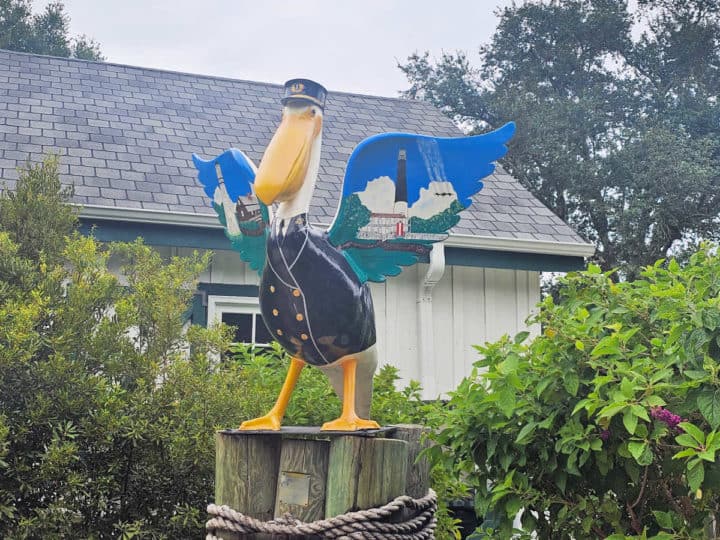
Restaurants and Attractions nearby
National Naval Aviation Museum - Visit this great museum to learn more about Naval Aviation including the Blue Angels.
Fort Pickens, Gulf Islands National Seashore - Visit this historic fort on Santa Rosa Island in Pensacola.
Lillian's Pizza - Located on Perdido Key is one of our favorite local pizza restaurants.
Whiskey Joe's Bar & Grill - Located in Pensacola Beach this beach restaurant has great food and epic views.
Flora Bama Yacht Club - On Perdido Key, Florida is a great restaurant for live music, fun, and delicious food.
Flora Bama Ole River Grill - located across the street from the main Flora-Bama and offers great food, friendly staff, and amazing water views.
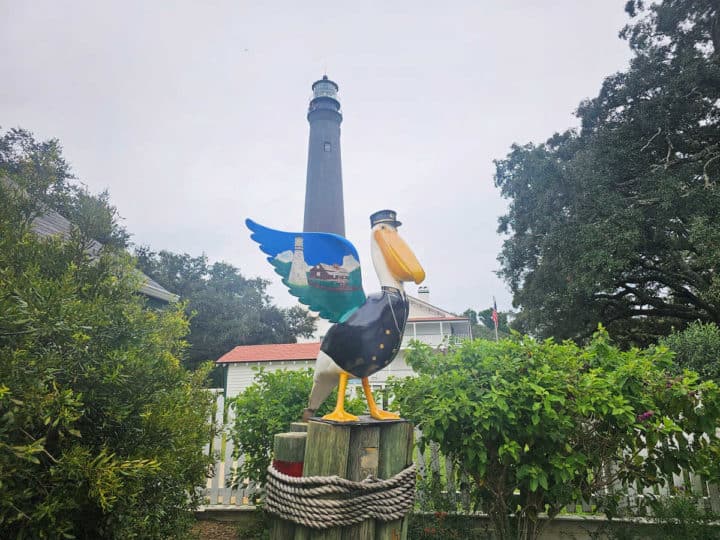
Pensacola Tours and Attractions
Seville Stroll Food Tour - Sample the great tastes of the Florida panhandle as you explore the historic area and taste local restaurants.
Hop On Hop Off Tour of Pensacola - Explore Downtown Pensacola on this great tour.
Ghosts and Graveyard Tour of Pensacola - Check out this guided, ghost-themed bus tour of Pensacola. Visit the historic downtown district, plus the Seville Quarter, Sanders Beach, North Hill, and a cemetery, of course.
North Hill Historic Home Tour of Pensacola - Visit the upscale North Hill neighborhood and discover historic houses that helped establish the city.
Downtown Pensacola Segway Tour - A guide will lead you on a fun Segway tour of Downtown Pensacola, including the Old Christ Church, Plaza De Luna Memorial Monument, and Plaza Ferdinand VII.
Pensacola Hotel and Lodging
If you are visiting and need to book accommodations, here are our recommendations.
Springhill Suites Pensacola - Enjoy comfortable rooms, an outdoor pool, free self parking, and easy access to Pensacola.
Holiday Inn Express Pensacola - Fantastic family-friendly hotel
Lily Hall - Great boutique hotel in Downtown Pensacola.
The map below shows the current hotels and vacation rentals available in the area. You can select the dates you are visiting to see current availability.
Additional Gulf Coast Articles
Best breakfast restaurants in Pensacola Beach - Our favorite breakfast spots on Pensacola Beach!
Pensacola Beach Boardwalk - Enjoy easy access to Quietwater Beach on Santa Rosa Sound, shopping, and great restaurants.
Peg Leg Pete's - This local favorite is known for great oysters and a fun atmosphere.
Shaggy's Pensacola Beach - Check out this great waterfront restaurant with delicious food and drinks. Pet-friendly outside!
Cafe Bistro - Super cute local restaurant with amazing puffy pancakes
Native Cafe Pensacola Beach - Delicious breakfast and lunch restaurant down the street from the pier.
We also have articles on the Emerald Coast of Florida, including Destin, Fort Walton Beach, Pensacola Beach, Navarre Beach, Panama City Beach, Perdido Key, Pensacola, and more.
Don't miss our other Gulf Coast destinations, including Gulf Shores, Orange Beach, Dauphin Island, Fairhope, Fort Morgan, Foley, Mobile, Bayou La Batre, Alabama, and so many more!
Keep an eye out for articles on the Gulf Coast of Alabama, Mississippi, Louisiana, Texas, and Florida!
Check out our Facebook, Instagram, and TikTok pages for more great ideas for the Gulf Coast.

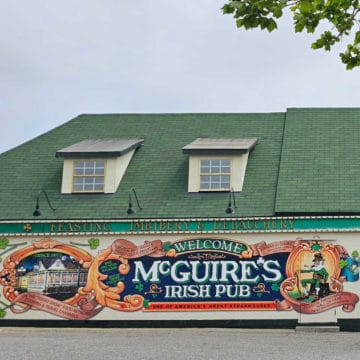
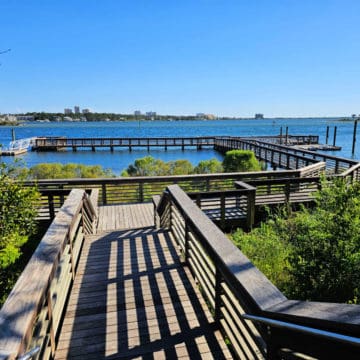
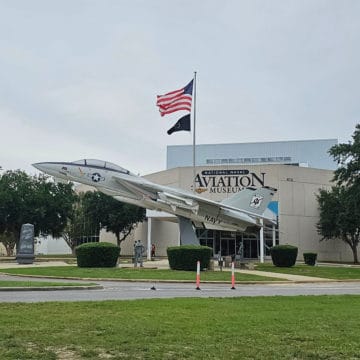

Leave a Reply